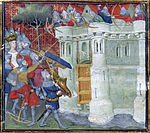Bristol Castle
Buildings and structures demolished in the 17th centuryCastles in GloucestershireEngvarB from September 2013Former buildings and structures in BristolHistory of Bristol ... and 1 more
Scheduled monuments in Bristol

Bristol Castle was a Norman castle built for the defence of Bristol. Remains can be seen today in Castle Park near the Broadmead Shopping Centre, including the sally port. Built during the reign of William the Conqueror, and later owned by Robert FitzHamon, it later became an important royal castle and happened to be the scene of several imprisonments and executions. Several fortifications and additions to the castle were made between the 12th–13th century under Robert of Gloucester and King Henry III. It was mostly neglected by the 16th century and torn down in 1656 under orders from Oliver Cromwell.
Excerpt from the Wikipedia article Bristol Castle (License: CC BY-SA 3.0, Authors, Images).Bristol Castle
Newgate, Bristol Broadmead
Geographical coordinates (GPS) Address External links Nearby Places Show on map
Geographical coordinates (GPS)
| Latitude | Longitude |
|---|---|
| N 51.455944444444 ° | E -2.5881972222222 ° |
Address
Bristol Castle
Newgate
BS1 3EH Bristol, Broadmead
England, United Kingdom
Open on Google Maps










